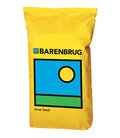Improving animal health through adding clover to a sward may not be immediately obvious, but as Ms Dawson explains, the nutritional qualities make it a very appealing addition: “Grass species alone are most commonly deficient in phosphorous, magnesium, copper and cobalt, whilst clovers tend to be higher in these elements, making them an ideal companion for grass to balance the sward.”
White clover is the most flexible option for both cut and grazing systems. Depending on conditions, it can fix up to 150kg N/ha/per year, helping to reduce inputs, and its creeping habits can fill gaps created by damage or unproductive grasses. It can also improve sward digestibility in mid-summer. Farmers should be aware that not all clover is the same, as Ms Dawson explains.
“Although white clover can be a flexible addition, red clover is less suited to high traffic and high grazing, as it grows from a single crown which must be protected to ensure persistency. That said, it is a good companion to Italian, hybrid and perennial ryegrasses for silage production, but doesn’t like sitting in wet soils.”
This is where getting the correct advice from experts can really be the difference between sowing a productive sward with the potential to return increased outputs for many years, or needing to do remedial works in the short term to patch up any areas that are underperforming, advised Ms Dawson.
Animal health benefits
Moving away from a familiar grass variety can be a worry, but growing a species that can help alleviate some health concerns could be a worthwhile investment. This is where a soft leaved tall fescue (SLTF), that helps stimulate rumination, can be a real benefit.
“SLTF does not increase lignin content when mature, keeping crops highly digestible later in the year and high in feed value. Collaborative research with global animal nutrition experts, Nutreco, showed that with SLTF there were rumination increases compared to varieties of grass low in cell walls such as Italian and perennial ryegrass.”
Other benefits of SLTF include having deep roots, which helps soil structure, along with being extremely drought tolerant – a big consideration for farmers going forward after this summer. They also suit multi-cut systems and have heading dates like intermediate ryegrasses. Regardless of the species, sward management is key to ensure the potential is achieved.
Additional species
Multispecies swards are popular and farmers shouldn’t be put off by the potential complexity required, as some of the simplest mixes can offer huge benefits from three or four species.
Herbs such as chicory can play a big role in sward diversity. Chicory contains a long taproot and has been refined to produce optimised leaf and stalk ratio. “This improves the feed value and means the crop can be mowed frequently. Chicory is commonly used as an addition to grazing leys due to its high protein content of around 17%.”
Other perennial herbs such as Sheeps Parsley and Burnet all have well developed root systems and offer diversity to the grass species, but well managed grazing is key to ensure that the species are maintained in the sward and not overgrazed or competed out.
Benefits of Condensed Tannins (CT) through species inclusion can return improved milk production, better fertility, and immunity. However, farmers should be aware that it has antinutritional effects, too, such as reduced feed intake, impaired digestion, and subsequently, slow productivity, so these species should only be included at low proportions of a mix.
CT can also reduce the effect of bloat because of better protein utilisation and reduced rumen protein degradation, meaning lower ammonia gas production. “Another environmental benefit is a reduction in methane (CH4) produced by directly affecting methane producing microbes in the gut, or indirectly by reducing fibre digestion,” says Ms Dawson.
Plants containing CT include Bird’s-foot trefoil and Sainfoin, white and red clover flowers.
Other grass options
Ryegrasses are the most common in the UK and are made up of diploids and tetraploid varieties, with diploids offering more seeds per kilo and more tillers per plant, so promote ground cover and longevity. Tetraploids have slightly higher water-soluble carbohydrates, less fibre due to larger cells and thicker roots. They are also a must for high input systems as ryegrasses are 100% responsive to nitrogen.
Perennial ryegrass (PRG) mixtures can cater for all types of cutting and grazing systems. However, it is worth assessing your current mix as it could be the wrong one for the soil and the system, explains Ms Dawson.
“This is where it comes back to knowing what your goals are. Moving to a multi-cut system requires a mixture with a much closer heading date pattern (up to 1 week) so keeping the crop uniformed is key. PRGs have yield potential up to 17tDM/ha and can last for seven years with the correct management.”
Another option for inclusion should be Timothy, which is palatable and has a heading date on par with perennial ryegrass, so is a good bedfellow. There are plenty of options for farmers looking to improve sward quality, but getting the correct advice on where production increases can be made, is essential.



